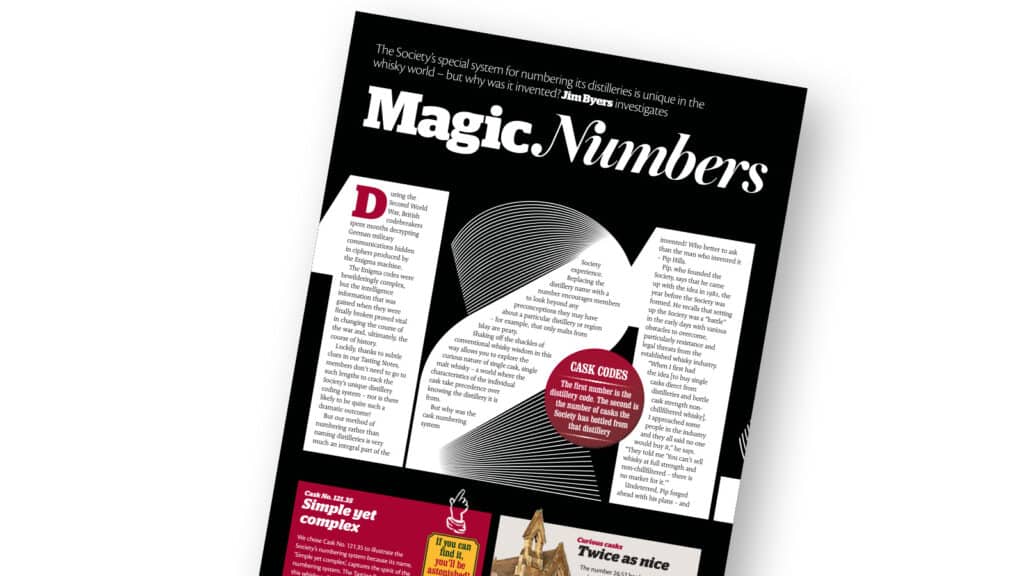During the Second World War, British codebreakers spent months decrypting German military communications hidden in ciphers produced by the Enigma machine. The Enigma codes were bewilderingly complex, but the intelligence information that was gained when they were finally broken proved vital in changing the course of the war and, ultimately, the course of history.
Luckily, thanks to subtle clues in our Tasting Notes, members don’t need to go to such lengths to crack the Society’s unique distillery coding system – nor is there likely to be quite such a dramatic outcome! But our method of numbering rather than naming distilleries is very much an integral part of the Society experience. Replacing the distillery name with a number encourages members to look beyond any preconceptions they may have about a particular distillery or region – for example, that only malts from Islay are peaty.
Shaking off the shackles of conventional whisky wisdom in this way allows you to explore the curious nature of single cask, single malt whisky – a world where the characteristics of the individual cask take precedence over knowing the distillery it is from.
But why was the cask numbering system invented? Who better to ask than the man who invented it – Pip Hills.
Pip, who founded the Society, says that he came up with the idea in 1982, the year before the Society was formed. He recalls that setting up the Society was a “battle” in the early days with various obstacles to overcome, particularly resistance and legal threats from the established whisky industry. “When I first had the idea to buy single casks direct from distilleries and bottle cask strength non-chillfiltered whisky, I approached some people in the industry, and they all said no one would buy it,” he says. “They told me, ‘You can’t sell whisky at full strength and non-chillfiltered – there is no market for it.’” Undeterred, Pip forged ahead with his plans – and then encountered another problem. “As the names of all whiskies are registered trademarks, I was advised that, if we put the name of the whisky or distillery on our bottles, we would be open to legal action for infringement of trademark. Not only that, it would generally put people’s backs up in the industry, and they wouldn’t sell their whisky to us.”
And so the Society’s coding system was born. “I decided to make a virtue out of a necessity and created the numbering system,” says Pip. “We chose not to use the name of the distillery and used an identifying numeral which, through clues in the Tasting Notes and information in our newsletter, could be connected to the whisky.”
The first Society bottle, released in September 1983, was from Glenfarclas – it was given the number 1.1 – the first bottling from the first distillery. It was 9 years old, 54% AB and was sold for £13.45!
Since then, the Society has bottled casks from 127 distilleries (plus seven grain distilleries which use the ‘G’ prefix in the distillery code), with new releases from a 128th distillery due soon. By 1 October, the Society will have bottled around 3,597 single casks since 1983.
Pip adds: “When we introduced the idea of having an unusual name for each bottle, once again, people in the industry said ‘Don’t be daft, you can’t do that!’ But, together with the idea of bottling single cask, single malts and using the numbering system, it was completely revolutionary at the time. And people liked the idea – they enjoyed having privileged access to casks and also the arcane information we provided.” The distillery coding system has remained one of the most significant aspects of the Society’s identity – one which Andrew Derbidge, Director & Cellarmaster, NSW manager, of the Australian branch of the Society is particularly fond of.
“Being a structural engineer, perhaps I’m more numerically minded than others,” he says. “So, given that, and my role with the Society here in Australia, I’m far more likely to fondly remember the merits and jovs of 27.81, than to recall the traits of ‘Old school desks and hibiscus!”

